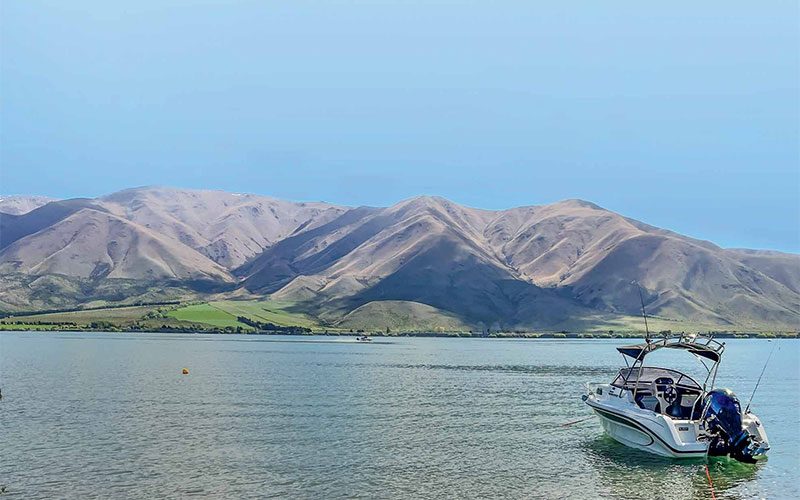

I essentially grew up in my late father’s agricultural engineering workshop. My brothers and I started jetboating at a young age on the braided rivers of Canterbury – roped in to make up crew by adventurous uncles. While there were lots of exciting trips, I also remember us being jettisoned as excess ballast and left to cool our heels in the riverbed under a baking sun until picked up again on the downriver journey.
JETBOAT ADVENTURER
After such an early introduction, it should be no surprise I bought my first jetboat at age 23, a fibreglass ‘Cougar’ hull, powered by a Holden 308ci V8 with a three-stage Hamilton jet. That’s when I began my first ‘career’ as a recreational, adventure jetboater on the rivers of the South Island’s east coast, from the Wairauahiri (flowing out of Lake Hauroko, on the edge of Fiordland, New Zealand’s steepest river), right around and up to the Wairau in Marlborough.
My catch-cry in those days was: “If you’re not hitting the bottom, you’re not trying hard enough!” I remember twice boating back to the trailer with water around my ankles, despite both bilge pumps running. Eventually this prompted an upgrade to a new Hamilton 141A hull (aluminium hull with fibreglass deck).
A highlight back then was boating nine rivers in four days – the Shotover, Kawarau, Dart, Rees, Matukituki, Makarora, Wilkins, Young and Hunter.
There were many other adventures too, like boating the full length of the Clarence River (around eight hours each way, carrying a 44-gallon drum of fuel and refuelling at the top for the downriver leg).
Another time, we boated the Buller River on the West Coast. All 14 boats on that trip suffered damage: one was sunk and lost, another sunk and recovered by helicopter the following day, while my own boat ended up 14 inches (36cm) shorter after colliding with a cliff. The whole side had to be replaced. Other trips included the Upper Grey, which back then had only been boated a handful of times.
Apart from jetboating, I’ve spent a lifetime hunting and fishing, which has taken me off the beaten track, teaching me tough lessons about reliable, fit-for-purpose transport – and what happens when said transport lets you down.
A successful but unsatisfying career start in accounting, with a foray into IT, preceded a switch to operations/production and eventually – after jumping around several industries – a stint with Fi-GLASS Boats as its first Manufacturing Manager, starting in 2003.
They say if you want to continue enjoying a hobby, don’t adopt it as your vocation. This is how it was for me, at least in part, but the financial and other demands of a young family were also significant factors in my hanging up my jetboating boots. Which is really where this chapter of the story begins…

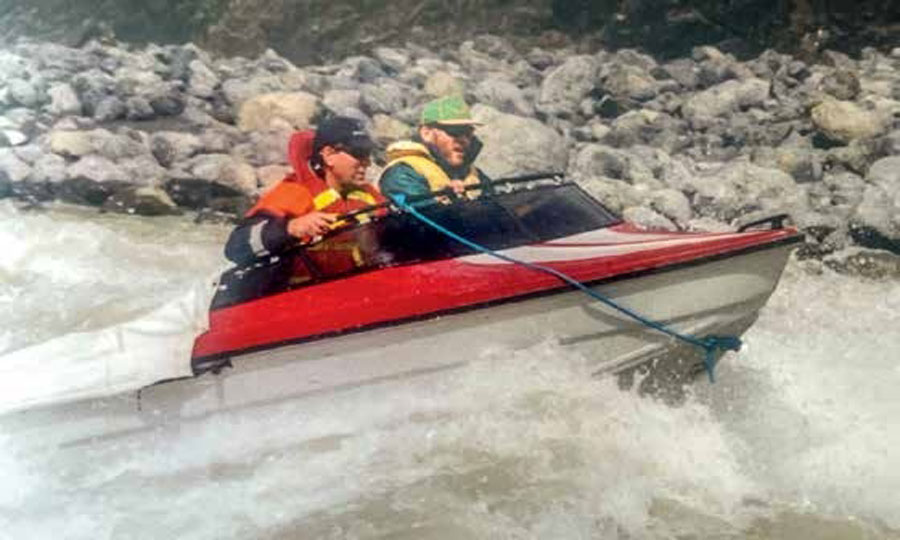
ICONIC BOATBUILDER
Founded in 1958 by the late Frank Simpson, Fi-GLASS Boats wears the manufacturing ‘longevity crown’ for trailerable, fibreglass powerboats in this country. More than 13,000 FiGLASS boats have left the factory since 1958, with Frank’s son Griff having long since taken the reins as Managing Director and owner.
When I joined Fi-GLASS the goal was to significantly ramp up production. We sold boats into the Pacific Islands, Australia, and even Russia, before the Global Financial Crisis and the Christchurch Earthquakes put a dampener on things.
While at Fi-GLASS, I began study for the New Zealand Certificate in Boat Building (Level 4 Composite Strand). Along with my jetboating background and work at Fi-GLASS, this course helped to crystallise my knowledge and opinions around a few things in the boating world.
For example, what a great marketing job aluminium boatbuilders have done to gain such a large share in the pleasure boating sector! This despite the significant drawbacks of using aluminium in production (volume) boatbuilding.
In my opinion, practically every production aluminium boat has, to some degree, a compromised hull form, due to the constraints flat sheets of aluminium impose. A fibreglass hull – take the Fi-GLASS Lightning, for example – can combine a fine bow, deep-vee for’ard, planing strakes, chines, and variable longitudinal deadrise through to a 22° transom with no flat spots. That is practically impossible to achieve economically for aluminium production boatbuilders, so many production alloy boats suffer compromised handling, performance, and ride.
The second drawback relates to aluminium’s impressive thermal conductivity. An aluminium boat feels cool to the touch when it’s in the water – fine on a hot day, but it’s downright unpleasant in winter. A fibreglass boat doesn’t transmit heat/cold in the same way.
I reckon going to sea in an alloy boat is a bit like boating in a floating chilly bin and consider the boating experience aboard a fibreglass boat to be far more pleasurable in cooler temperatures.
There’s a reason why my jetboat has an aluminium hull and a fibreglass deck!
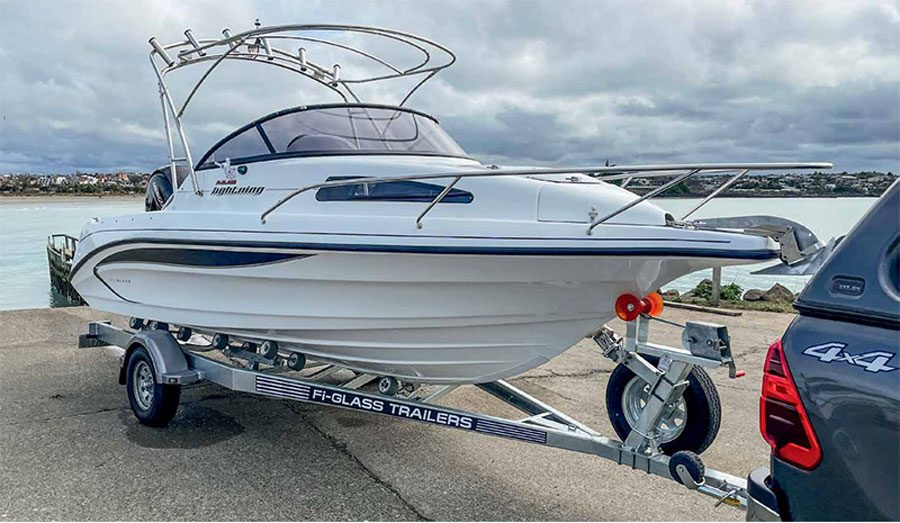
UNFINISHED BUSINESS
Eventually, my career took me away from Fi-GLASS, although not before my boating passion had well and truly gone into hibernation.
But that’s the thing about hibernation – it does come to an end. Fast-forward 12 years, and the opportunity finally arose to address unfinished boating business – it was time to buy a new boat. And with my background, Kiwi-made FI-GLASS was the obvious choice.
While still at Fi-GLASS, I had concluded that what people really NEED in a boat is a suitable hull, trailer, and propulsion system. After that, it’s just a question of how much more money you WANT to throw at it.
Fi-GLASS has always understood this pretty well, largely resisting the temptation to add a whole lot of (costly) standard features not everybody wants. That’s how they keep their boats priced within reach of the average family boatie. However, once you’ve decided on your new boat, there’s no reason why you can’t pimp things up a bit – and there are so many equipment options available, and so much technology.

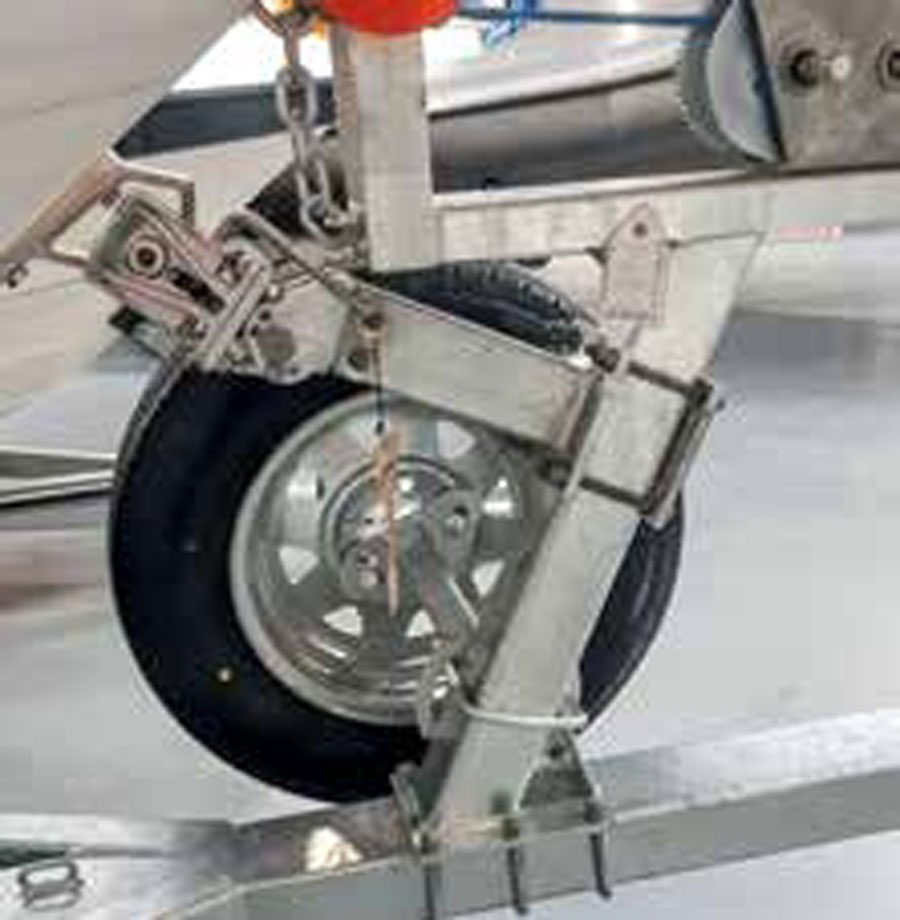
MY VISION
I had no hesitation in going with a Fi-GLASS Lightning. I know this boat can do what the label says it can. I know the production process inside out and I spent eight years interacting with Lightning owners – if there was something wrong with the boat, I’d know about it!
In my case, we’re talking about a boat that will be used in coastal waters, and also on the lakes of the lower South Island. It will spend time fishing, indulging in water sports, and just plain pleasure-boating. It needs to be capable of finding itself in Fiordland, and across the strait at Stewart Island. Within the bounds of responsible boating and good decisions by the skipper, it should easily handle all of the above.
But not without a bit of pimping out! The idea is to have a boat that can be driven by anybody (within reason), experienced or not. So that means ironing out ‘complications’ – like launching and retrieving – and variables like managing engine trim, hull pitch and roll. To meet the vision, the boat clearly needed to be robust, which the Lightning is, but with upgraded equipment.
Griff and I did discuss the outboard size – and whether there was an intermediate option between 115hp and 150hp. Griff counselled against this, but I also later realised my competitive nature would never have allowed me to entertain any such option. How could I possibly have a smaller outboard than my younger brother (who’s owned his Fi-GLASS Lightning for nine years)?
My brother confirmed the drum winch as definitely the way to go, also suggesting a couple of additional upgrades, resulting in an uprated sounder/fishfinder; a VHF Radio with the speaker in the handset (so you can put it up to your ear to hear what the other person is saying in rough conditions); and a sealed bulkhead in the underfloor storage locker.
Subsequent upgrades included a Boatcatch (to allow singlehanded launch and unassisted retrieves); Mercury ActiveTrim (automated trim management); Zipwake dynamic trim system (automated management of pitch and roll); modular bait board complete with rod and drink holders; standard compass (atop dash); rode counter (so the skipper can see how much anchor rode is deployed); stainless-steel skeg guard (to help protect against skeg damage); a spare, easy-stow foldable box-anchor; a stern anchoring kit; additional storage nets in the cabin; and additional fishing equipment (rod holders, rods, landing net, gaff).
I’m still researching the wisdom of a prop guard, to minimise the risk of propeller damage.
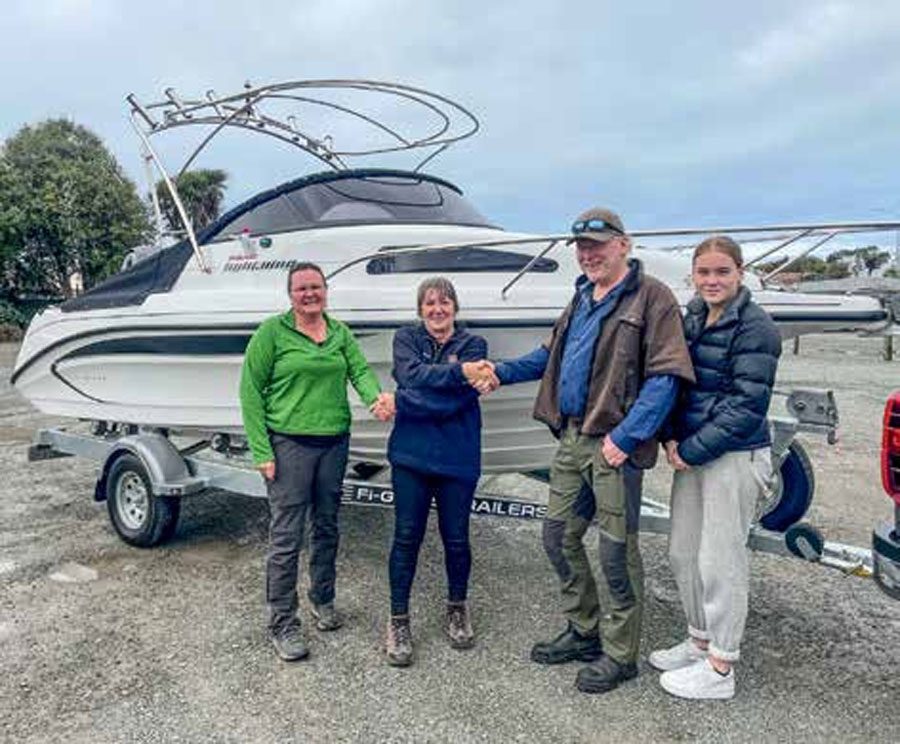
WHAT’S IN A NAME?
Originally, we decided upon Hy Time, but that has since changed to Wildstrike – a nod to the model name and the up-spec’d nature of this particular vessel. BNZ
SPEC’ING THE BOAT
I started out by saying to Griff: “Spec it as if you were building it for yourself.” Discussions around that took care of quite a few things (and a fair sum of my money). Here’s Griff’s list:
Drum winch
Ski pole
Rocket launcher/Bimini (with clears), featuring wakeboard tow point 150hp Mercury outboard (up from the more ‘standard’ 115hp)
Hydraulic steering
Dual batteries
Centre infill for cabin bunks
Additional passenger grab rail
USB charger
Cockpit lights
EPIRB
Fenders
Boat hook
Life jackets
Flare kit
Trailer spare wheel kit




